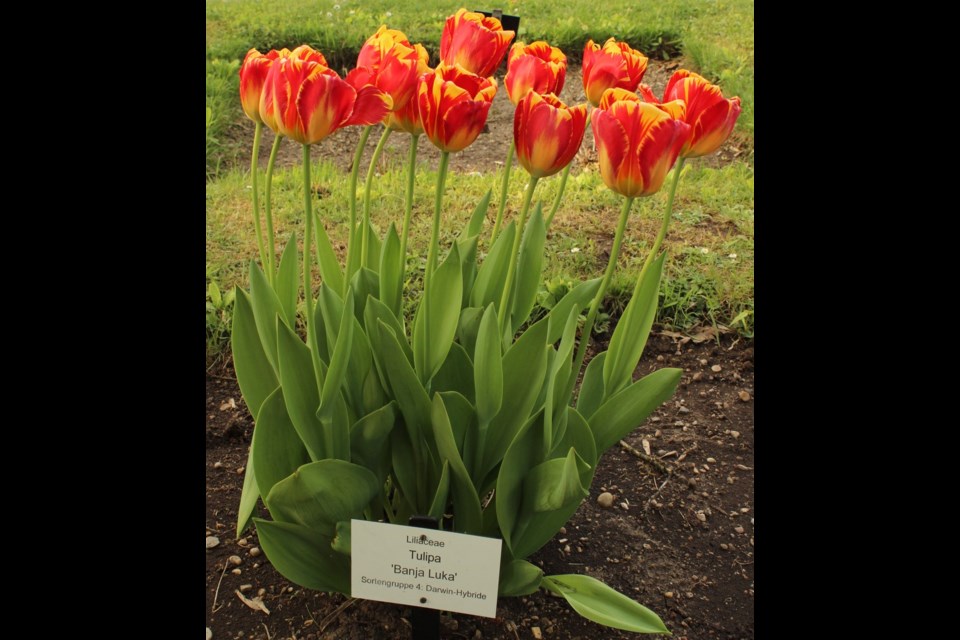Tulips add spring colour to our perennial and mixed borders as well as in annual beds. Native to the mountainous areas of Asia from Turkey through Siberia, the genus name, Tulipa, is from the Turkish tulbend, meaning turban, a reference to the shape of the flower.
They have been the centre of the bulb industry since the 1500s when Turkey initiated a flourishing trade. Cultivated and hybridized in Turkish gardens for centuries prior, they were introduced to Holland and the garden of Carolus Clusius, a botany professor at the University of Leiden, about 1593. Stolen from his garden by botanical thieves, they quickly gained popularity among the wealthier Dutch. By the 1630s, “Tulipmania” was in full swing in Holland. Amid much speculation, enormous prices were paid for single bulbs, many with unusual striping or mottling. Unfortunately, these bulbs were not long-lived and many fortunes were lost. Both the unusual colouring and their short life were due to a virus.
Nothing is more enticing than garden centre shelves full of plump tulip bulbs in September with their implied promise of spring bloom. Although widely advertised and readily available, growing tulips in the colder areas of the Canadian prairies is often disheartening. The harsh reality is that many of these are not reliably hardy on the prairies. Some will come through their first spring and then fail to appear in subsequent years. Others may not appear at all.
Of the approximately 5.000 tulip varieties available today, the Darwin varieties listed below are among your best bets for reliable spring colour on the prairies. They combine drought tolerance, hardiness and a more perennial habit than most.
First introduced in the early 1950s, Darwin hybrid tulips are a cross between single late tulips and early emperor tulips that were first made by Dutch hybridizer D.W. Lefeber. Their parentage gives them their large, shapely blossoms and a relatively early bloom time. Depending on the season and your location, Darwin hybrids typically bloom between mid-April and mid-May. They are generally tall plants with single flowers of good size and colour on sturdy stems. Most are 18 to 22 inches (45-55 cm) tall.
Purchase the largest, plumpest bulbs as soon as they become available in the fall and plant them immediately in well-drained soil in full sun. Water well, mulch, and hope for an early and continuous snow cover – their best insulation!
Among the older Darwin hybrids, generally red, yellow or orange, are:
‘Apeldoorn’ – red with persimmon-orange edges and interior (in case you’re wondering, Apeldoorn is a city in Holland).
‘Beauty of Apeldoorn’ – yellow washed with orange.
‘Golden Apeldoorn’ – golden-yellow.
‘Golden Oxford’ – golden yellow.
‘Oxford’ – scarlet flushed with red.
‘Parade’ – red, large black interior base edged with yellow.
‘Pink Impression’ – large pink-rose flower.
The more recent Darwin hybrids also include pinks, whites and purples:
‘Acropolis’ – iridescent rosy-pink flowers.
‘Ad Rem’ – fragrant, scarlet petals with a gold band.
‘American Dream’ – golden-yellow with reddish-orange edges.
‘Apeldoorn’ Elite’ – red-orange petals with golden edges.
‘Apricot Impression’ – apricot-orange with a yellow edge.
‘Apricot Pride’ – apricot-pink to peachy yellow.
‘Banja Luka’ – yellow with broad red edge.
‘Beauty of Spring’ – extra-large, pale-yellow petals delicately edged in crimson.
‘Delta Graffiti’ – pinkish-red exterior with cobalt-blue centre edged in black.
‘Hakuun’ – pure white flowers.
‘How Sweet It Is’ – peachy-apricot with a golden edge.
‘Ivory Floradale’ – cream with a slight pink hue.
‘Juliette’ – bright golden flowers with a scarlet flame.
‘Mystic Magic’ – reddish-pink flowers on compact plants.
‘Novi Sun’ – sunny yellow, 2020 introduction.
‘Ollioules’ – rose-red fading into ivory white on the edges.
‘Orange Queen’ – mandarin orange-red with yellow glow on outer petals.
‘Pink Sound’ – soft candy pink petals with cherry pink edges.
‘Red Impression’ – deep red.
‘Rise Up’ – salmon-pink petals with a golden yellow base.
‘Salmon Impression’ – pink petals with salmon-apricot flushed in their centre.
‘Triple A’ – rich orange with delicate orange edging.
‘Wedding Dress’ – pure white, 2020 introduction.
‘White Clouds’ – snow white.
‘World Friendship’ – creamy-yellow; symbol of peace and friendship.
Sara Williams is the author of many books including Gardening Naturally with Hugh Skinner, Creating the Prairie Xeriscape, and with Bob Bors, Growing Fruit in Northern Gardens. She gives workshops on a wide range of gardening topics throughout the prairies.
This column is provided courtesy of the Saskatchewan Perennial Society (SPS; [email protected]). Check our website (www.saskperennial.ca) or Facebook page (www.facebook.com/saskperennial) for a list of upcoming gardening events.
You can no longer count on social media to deliver important news to you. Keep your news a touch away by bookmarking SASKTODAY.ca's homepage at this link.
Here's why you should bookmark your favourites.
Subscribe to SASKTODAY.ca newsletter to get our daily news to your inbox.




